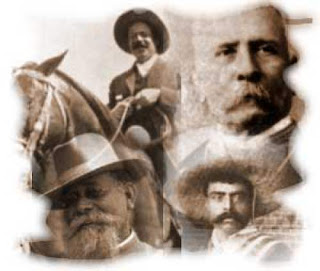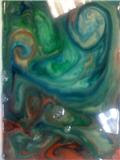Labels
- English (5)
- Español (7)
- Humanidades (5)
- Math (5)
- SAS (1)
- Science (6)
- Social Studies (2)
- SSL (1)
Tuesday, October 26, 2010
Dancing and singing to math
Who said Math is boring !?!
Monday, October 25, 2010
Expresar nuestras ideas a través de la escritura.


CREATING ART IN SCIENCE
Here are just a few wonderful examples!
Learn how we did it!
Introduction
Liquids like water and milk have a property known as surface tension, due to the cohesive forces of the liquid's molecules. Look closely (you can use a magnifying glass) at the edge of the surface of water in a clear glass. Do you notice how the very edge of the water appears to rise up the side of the glass? That's because the surface tension of the water is actually pulling the water away from the glass inward toward the center of the surface.
Soap will reduce this surface tension. Let's see what happens!
Safety
- Make sure you have an adult helping you.
- Do not drink the milk after you have put the food coloring and soap in it!
- Do this experiment near the sink so that when you're done you don't spill milk and food coloring all over the floor.
Supplies
- A shallow dish - One that is clear is best, to see what's happening under the surface of the liquid, but a shallow bowl, aluminum pie tin, or plastic or paper bowl will work just fine.
- Milk - The higher the fat content the better. Buttermilk, half-and-half, or whole milk works best.
- Food coloring - Four different colors will be more colorful.
- Liquid dish soap.
- A toothpick or small straw might be helpful, too.
Directions
- Pour a layer of milk in the dish about 1/2" (1 cm) deep. Room temperature milk works better than cold milk, if you have the patience to let it sit for a while.
- Carefully put one drop of each of the four food colors onto the surface of the milk, widely separated, and not in the center of the dish. Something like this:
- Get ready to watch what happens! Very carefully drop one drop of dish soap onto the surface of the milk in the center of the dish. (Be careful not to add the soap directly on top of the food coloring. You may want to dip a toothpick in the dish soap so that a small drop of soap remains on the end of the toothpick, then touch the drop to the surface of the milk.)
Observations
- What happens to the food coloring when you first put it on the milk? Why do you think that is?
- What happens when you add the drop of soap?
- What direction does the food color move when you first add the drop of soap?
- What direction does the food color move after the experiment has been running for a while?
- Does the movement go on forever? What happens?
- What happens if you add another drop of soap after the colors have stopped moving?
What's Happening?!?
You probably first noticed that the drops of food coloring just sat on the surface where you placed them. That's because food coloring is less dense than milk, so it floats on the surface, and the colors do not mix because you didn't stir the milk.
Then the action began with a drop of soap! The soap reduces the surface tension of the milk by dissolving the fat molecules, which is why fattier milk works better. The surface of the milk outside the soap drop has a higher surface tension, so it pulls the surface away from that spot. The food coloring moves with the surface, streaming away from the soap drop. Due to the convection that results from the moving surface, the food coloring may be drawn down into the liquid, only to appear rising again somewhere else. That's why it's best to use a clear bowl so you can see what's happening.
As the soap becomes evenly mixed with the milk, the action slows down and eventually stops. Addition of another drop of soap will start the process again.
Friday, October 22, 2010
Hatchet Survival Guides!



Journal Assignment: Free Topic

Dear Ms. Nash,
Today I’m writing about if I would have three wishes what would I choose. My first would be that everybody in my family is healthy, because I care a lot for them. My second would be that people would lean to take car of the nature and water, because I see that 80 percent of the people in school don’t care about the nature. My third wish is that people in Africa don’t starve for anything and they can get a place to live, food and clean water, a place to sleep, rain and medicine. That would be my three wishes. I hope you understand me, I don’t ask for anything just for me. I ask it representing every single person that agrees with me. Thank you Ms. Nash.
Alec
Bravo México.
Suspenso en la bahía
 Noticia Español. Ms Hinojosa
Noticia Español. Ms HinojosaUn libro más de tantos que vamos a leer durante este ciclo escolar. Cada historia nos invita a una nueva aventura ; éste en especial es un libro que los niños están disfrutando mucho.
Advice From Ms. Nash’s 6th Grade Students
What Does A Quality Conversation Sound Like?
- No interruptions
- Think before you speak
- It sounds polite
- Participation
- Eye-contact
- Listening to each other
- Tell the truth
- Compliment each other a lot
- Themes are important
- Words are respectful
- No negative comments about a person
- Words are pronounced correctly
- No inappropriate conversations
- Reply when someone asks a question
Dr. Kissel's Math Class, by Aldo
Comparing fractions was difficult for everybody, but everybody survived it. Turning fractions into decimals and decimals into percents was a very easy thing to learn. We found out how to do word problems with fractions, too. Everybody had a little difficulty with those. We also completed as many problems as we could in a minute at the beginning of some classes. Those are called Mad Minutes and some were even fractions.
Finally, besides all that learning, we did a fun thing. That was funky halves and funky quarters or fourths. We divided arrays of dots into 2 parts and then 4 parts in creative ways. With the fourths we made awesome quilts. This is what we learned in our first middle school cycle.
Dr. Kissel's Science Class, by Marina
Our class’s recent project was writing a biography of a Famous Scientist that we could choose. Examples are Jane Goodall, Isaac Newton, Albert Einstein, and many more. The project was from a minimum of 3 to 5 or more pages. We also had to do a works cited page. If you do not know it, that is a bibliography where we wrote all our sources that we used to get all our information. Maybe this part was boring, but it was also pretty fun.
In class we also had some tests, like one on the many types of scientists. First we had to do a worksheet and look for all the types of scientists and then we had to study about 20 or so, but it was easy because we learned mnemonics, memory tricks. An ichthyologist studies fish and fish are icky, so we could remember that. Do you know what an ornithologist studies? No? Yes? Well, I first thought it was a person who studies “ornithorincos,” or in English “platypuses.” No. An ornithologist is a person who studies birds. Birds have nothing to do with platypuses. We remembered that because the whole in a birdhouse is shaped like the letter “o” and ornithologist starts with that letter.
We also studied observations and inferences recently. You are probably wondering what those things are. Maybe you think they are very hard words but, “No way Jose.” They are, “easy peasy lemon squeezy.” We learned that we make observations using our 5 senses. You use logic. Our teacher gave us a candy (we did not know what it was) and with our eyes closed we needed to feel it, listen to it, and smell it. Then we could see it. The fun part was we ate it and tasted it. An inference is an explanation of an observation. It is what you think or imagine about the object or picture. The candy tasted good and the class was excited about the candy. Those are inferences from observing.
I could tell you much more, but I think you will not want to hear it because you will feel VERY JEALOUS. I hoped you enjoyed reading and I hope that you know that we love this class and our teacher.
Study Tips from the 6th Graders!

Nervous about studying for Middle School tests?
Read these tips put together by 6th grade Social Studies students for their Early Hominids test (many of whom got an A!)
1) Don't cram the night before! Studying a little bit each day is much better.
2) Get a study buddy or form a study group.
3) Teach the important information to someone else - if you can teach it you know you understand it!
4) Don't panic! Get a good night's sleep and eat a healthy breakfast.
5) Make flashcards and a study guide - only focus on the important information, don't try to cram everything in!
Friday, October 8, 2010
SERVICES FOR ACADEMIC SUCCESS
Student-Led conferences will take place on November 4th. Make sure you sign up for your prefered time as soon as possible!
NUESTROS VALORES PREVALECEN

En este 2010, cuando se cumplen doscientos años del inicio de la Guerra de Independencia, y cien de la Revolución, a gran parte de nosotros nos parece que estos sucesos no tienen una relación directa con nuestra vida. ¿Cómo establecer una verdadera conexión emocional con ese pasado?
La respuesta está en reconocer que su misión estuvo guiada por los mismos valores que hoy nos esforzamos por mantener vigentes como la generosidad, la amistad, la templanza por solo citar algunos; aunque también fueron escenarios de antivalores que nos preocupan: la traición, la arrogancia, la violencia, la ambición. Con esto en mente el ánimo de celebración tendrá un verdadero sentido en la vida de nuestros niños para conservar y engrandecer la identidad nacional.








